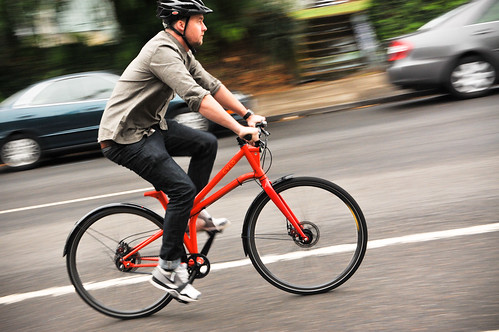
(Photos by J. Maus/BikePortland)
A new Portland-based bike brand is trying to presell its first model in order to take a crucial next step in its evolution. Eric Duvauchelle, co-founder of Cylo, has self-funded his company since it launched this past April. Now he needs to find 50 people that want his Cylo One city bike — and with those orders he plans to make the first production batch.
Duvauchelle, 35, grew up in a small town south of Paris and went to design school in London. At at a meeting at north Portland coffee shop last week, he shared his story from those early days in London to his current focus on Cylo. After graduation, he moved to New York City where he worked in the music industry packaging hip-hop albums. A job as design director for the Nike Soccer brand moved him to the Pacific Northwest and inner southeast Portland. As he moved to follow his graphic design career, he rode bicycles whenever he could, but it wasn’t until Nike assigned him to a project in Amsterdam that he “re-awakened to cycling.”
“In Amsterdam, I realized how bikes can be woven into society,” he recalled, “what bikes can do to you, to cities, to people. It’s really unbelievable.”
It was that realization, Duvauchelle says, that led to him eventually leave Nike, settle down in Portland and launch Cylo. “I was happy at Nike, but this was about doing something I could be passionate about.”
With his brother Antoine as a business partner, Duvauchelle looked to other designers he’d met at Nike to help him realize his vision of the ultimate city bike. Working with product designers who had “no bike experience at all” opened the Cylo up to criticism from online commenters after the bike got its first round of media coverage earlier this summer.
“It was criticized as a designer wank-off,” Duvauchelle recalled, “And yes, it’s true, our design agency had no bike experience. But then again I didn’t want to bring another diamond frame to the market. It would have been easy to import frames from China, slap stickers on them, and say ‘voila’ – a new bike brand.” (This is something Duvauchelle has experience with. Prior to Cylo, he co-founded Cycles Papillon, a company that imported titanium bikes from China. They sold about 60 bikes in all before shutting the company down. Duvauchelle told me it was a great learning experience and it allowed he and his partner to “get our feet wet.”)
Advertisement
Instead, Duvauchelle and his team are convinced they’ve come up with a bike that has the right mix of form and function. The Cylo One boasts integrated, dynamo-powered front and rear lights, disc brakes, fenders, lightweight aluminum tubing, and an 11-speed Gates carbon belt drive (three models will be offered, with a 3-speed version starting at $1,900 and the top-of-the-line going for $2,500). Not surprisingly, given its design-centric upbringing, the most striking feature of the Cylo One is its frame shape.
Glancing over at the bike as it leaned against a rack near our table, Duvauchelle said, “When people see this bike, they stop and turn and look. That’s important to us because there’s a need for something different in this saturated market.”
He’s right. The city bike market is much more crowded than it was just a few years ago. With the biggest brands in the industry offering many of the same features the Cylo One has, it will take a lot to get noticed. Duvauchelle’s tactic for attention might be working: the Cylo appears prominently in the new, design issue of Wired Magazine.
With a working prototype, Duvauchelle now hopes to move into production. The company has set a goal of 50 orders before pulling the trigger on the first batch (they’re up to 20 so far). Once that number is reached, Portland-based Zen Bicycle Fabrication will build the bikes.
“The presale,” Duvauchelle explained, “is our way of securing demand and to make sure we’re not throwing money out the window.”
Once the Cylo One is produced, Duvauchelle might expand into other products. His company’s motto is to “Design innovative and inspiration products for people on the move,” and that could mean fashion, bike accessories, or other types of products.
“We’re trying to build a brand, not a one-off product.”
— Cylo.cc

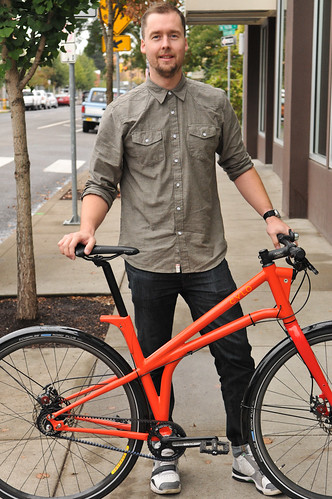
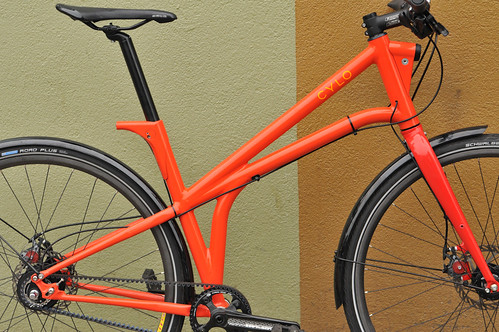
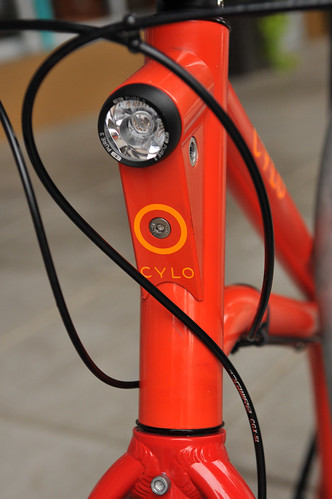
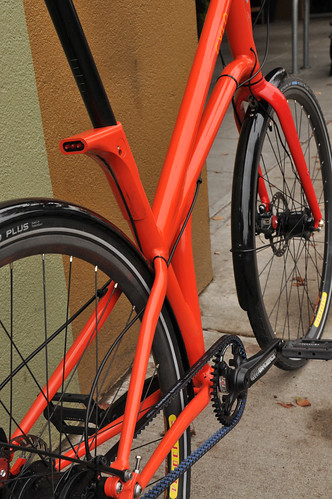
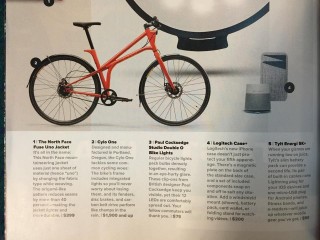
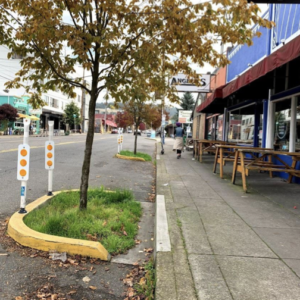



Thanks for reading.
BikePortland has served this community with independent community journalism since 2005. We rely on subscriptions from readers like you to survive. Your financial support is vital in keeping this valuable resource alive and well.
Please subscribe today to strengthen and expand our work.
one missing bit- the 11-speed starts at $2500 or so.
thanks tedder42. I meant to add the prices but forgot. They’re in there now.
Yeah… it looks like an awesome bike, but even with the $1900 (lowest-priced) model I would feel queasy about locking that up on any street.
Yes, I’m a little confused as to the use of a “utility” type of city commuter bike that is $2-3k.
I like the integrated lights though.
Looks like you can’t lock the frame and wheel to a staple with a u-lock.
Rear triangle and wheel looks like it would work (more people should be locking their bikes up like this already).
The Sheldon Method: http://www.sheldonbrown.com/lock-strategy.html
i don’t mean to be another internet-bike-hater but how is that a city bike? No chainguard, and you can’t carry anything anywhere but your back. I get the desire to do something different, but, well, an american-designed functioning city bike (that DOESN’T make a bunch of compromises in order to look/feel speedy or high-tech), now THAT would be something different. This reminds me of the Manifest entries: devoted to the notion that bicycles are somehow inherently flawed, and need to be redesigned. Which I think is untrue.
Great that he’s giving it a shot, though, and I like the business model. Maybe as they build their brand they’ll backwards-engineer some practicality into the mix.
“the notion that bicycles are somehow inherently flawed, and need to be redesigned. Which I think is untrue.”
Agreed. Nothing can’t be reinvented, but anyone trying to improve on the bicycle has some steep hurdles to overcome. The family of bikes we already have available pretty well covers the territory.
“I didn’t want to bring another diamond frame to the market.”
The frame looks self-consciously not a diamond frame, as contemporary suburban houses are self-consciously not symmetrical. Being different for its own sake is aesthetically risky, and can be expensive.
As a city bike I would think it should at a minimum have racks as standard equipment, front and back. Heck, for $2k they should be frame integrated like those nifty Ahearne ones. It looks to me like the rear light on this one will be obstructed by a rear rack. Even one without anything strapped to the top platform.
That front fender needs to go.
I wouldn’t think it needs to go– otherwise you’ll be getting spray up in your face. This is Portland, where I guess it sometimes rains or something.
Definitely needs racks, though. At least a rear rack.
I meant for a much longer one. I suspect your shoes will be soaked without a decent mudflap.
Oh, definitely agreed. I was going to say it needed to be longer, then spent about 5 minutes comparing the picture in this story to my own bike with fenders sitting next to me, and decided either I had short fenders too, or we both had standard ones.
Portland (n):
A city in Oregon where you can redesign a basic and practical European tool, make it worse, and sell it on an extreme mark up.
Has that LED been tested enclosed like that? Heat and LEDs do not mix.
I think the Front light is pointing down way too much. Shouldn’t it be pointing forward? Pot-holes be damned.
The light may be too bright and too blinky.
Looks like it to me too, especially if that beam has a good cut off. (Looks like a Supernova Pure 3).
I did have to point my halogen down almost that much with it’s round beam pattern. But a city bike should have a good cut off with well designed optics so it does look pointed wrong.
It should at the very least be adjustable. A designer shouldn’t try to predict where a rider would like to point the light.
So where is the frame welded up? That’s not enough money for a custom US job, but way too much money for an imported frame…
Portland-based Zen Bicycle Fabrication.
I forgot they existed… Cool!
Well, there are definitely mid-fork braze-ins for a front rack. It does seem like a rear rack would obstruct the rear light.
Also, one could use a u-lock through the rear wheel and frame. The front wheel looks to a bolt on, or perhaps pit lock type skewer which would be quite secure against theft.
Pretty we’ll thought out, though the price and ugly frame are tough to overcome. Though I suspect opinions on the frame vary widely; I see nothing wrong with a diamond frame.
The safest way to define the “ultimate urban utility bicycle” is that it has two wheels, handlebars, and some pedals. It can branch out in any direction from there.
My ideal bike started out something like the Cylo. After several iterations, the only commonality is a set of Supernova dynamo lights.
You probably have different wants and needs. They might be at odds with the Cylo, or for that matter, themselves.
Best of luck, Eric.
Some nice features on this bike. The rear light is a brake light (!) as well as a tail light. The lights are integrated and thus harder to steal (and, being unique to this bike, would have no street value). The belt drive should stay pretty clean in crappy weather, disc brakes are good for rainy climes too. Price out a belt drive, dynamo hub and good lights with stand light, those are all standard here. In fact, I think the price is either good or very good for a bike with all those features plus internal hub gearing. I like the looks, jaunty and different. I wonder if shorter riders will be forced into a very upright “sit up and beg” position, due to the high and long head tube. It would be interesting to know if they have a bespoke rack design that will work with the rear light. Presumably cable and wire routing will be cleaned up. Overall, I think it is interesting and attractive, and would make a nice commute bike, especially for a climate like ours, unless one is a speed demon.
Rei has a Novara branded bike for $950.
Belt drive, “chain” guard and rear rack. 3 speed, disc brakes, and paint matched fenders. You can add a hub dynamo wheel and lights for under $300. $150 less if you’re willing to use a bottle generator. In my opinion, its not a problem for a city bike, I’m running one now (though without the taillight).
If someone wants to pay a 50% premium for a Portland built bike, go ahead, but to suggest its a good value… I don’t think you can say that.
Point taken. Hard to compete on price with a made in China mass market bike. Take the Novara, add $300 for dynamo hub and bolt on lights ($400 if you want stand lights), $100 for theft-resistant skewers, you’re at $1300-1400-ish. No “brake light” though.
Where are you buying your skewers? Chris King?http://www.rei.com/product/705481/delta-cycle-axlerodz/?cm_mmc=cse_PLA-_-pla-_-7054810010&mr:trackingCode=714FDD84-078C-DE11-B4D4-0019B9C043EB&mr:referralID=NA&mr:device=c&mr:adType=pla&mr:ad=53280763120&mr:keyword=&mr:match=&mr:filter=70389950920&msid=0yublC6w_dc%7Cpcrid%7C53280763120%7C
Deltas are not theft resistant at in the slightest. A 5 mm allen wrench takes them right off, or two pairs of pliers. I was thinking of the price of Pitlock or similar. Admittedly I don’t know what Cylo plans to supply.
By the way, re-reading the spec sheet, I see the bike has reflective rims, Velocity Halos, retail for $100/ea, so that helps address the side visibility issue discussed below. In general, the component list looks very solid.
Although, look closely at the components spec’d on the Novara – they are distinctly lower grade than the Cyclo’s components, and the Novara weighs 32 lb, call it 34 lb with the lights and hub. Granted that includes a rack, but still it is 6-7 lb heavier than the Cyclo is claimed to be.
1 gear is enough–if it is fixed.
3 gears are more than enough–if one insists upon the “pernicious habit” of coasting.
And a front drum brake is much better than a disc brake–for a city bike.
I had the same philosophy until I moved to SW PDX and blew up my knees. Now me and my 24t granny are tight.
Fine, so get the 3-speed if that’s enough for you. And lucky you.
Personally, I ride over the West Hills every day. That’s a 500′ climb in the summer, and a 900′ climb in the winter when I don’t consider my summer routes safe enough. I used to do that commute on a 3-speed, and it was doable since my riding style tends to involve a lot of standing on climbs. But who would prefer to sit and spin and have a power/weight ratio similar to mine (or who carry loads on flatter terrain), 3 speeds is inadequate. Kinda nice they’re offering a choice, isn’t it?
A drum brake is better than a disk brake …. in what way, exactly? Those who haven’t ridden disks often assume they fade in wet weather, like rim brakes do — but that turns out not to be true at all.
Those mountain bikers are so clever…..
And as for drum brakes, I upgraded my folding bike to the Sturmey ones and they work great (much better than the dangerously weak Shimano roller brakes). But I don’t know of any advantage they have over disc brakes other than that you don’t need a disc-specific frame and fork.
I have a bike with each, both are great. Supposedly drum brakes are lower-maintenance than disc brakes (disc can get bent by other people when your bike is locked up, I hear?) I’ve only had the disc-brake bike for a year so maybe a bent disc is in my future but it hasn’t happened yet.
As a famous bike blogger once asked, what is it about design school that makes people think the bicycle is broken and in need of redesigning?
As a design school graduate, I have no idea. I hid my head in shame at the results of the last manifest.
It’s unfortunate how designers put so much effort into moving a few tubes around, but don’t change geometry or utility at all. In fact, nothing is really added to the bicycling experience by this particular machine compared to any other, and it even uses bearing spacing standards which haven’t changed in decades.
The secret to success in bicycle design isn’t in the frame. Take that as free advice, from me to you.
Relative to the traditional diamond frame, alternative frames with lower top tubes (or no top tubes) are convenient for some riding.
Yes, but there’s no compelling reason to have the downtube come up and make that arch. Having all the tubes come together in front of the seat tube, in what should be the front triangle area, creates a high-leverage hinge point that only weakens the frame and without a doubt makes the frame more expensive to manufacture.
This bike isn’t going to be torqued by a sprinter cranking 1500 watts or pounded on a downhill trail. It is a city bike, and plenty of city bikes have only a single large-diameter frame tube, often positioned very low, and are rigid enough for their intended use.
I don’t think the frame design is likely the main reason for the “higher than China” price. There are simply two additional bends and welds, compared to a basic diamond frame. I think the reason is simply what it costs to have a bike welded, painted, and assembled by American workers making a living wage.
Look, for example, at the Shinola bikes from Detroit, they start at $1950 with 3-speed hub and disc brakes, no dynamo lights or belt drive.
A single, large diameter tube would be better, and a more honest design. This is not that and has multiple, much larger miter and heat affected zones. As a former mechanic, I assure you that plenty of bike frames have been fatigued to failure by decidedly NOT sprinters.
Where’s the bottle opener? A city bike designed, built, and ridden in the micro-brew-orgey-fest that is Portland definitely needs one.
Amazing how such a progressive group piles on so much negativity on this design. Okay…maybe it’s not perfect by elite PDX standards, but is there anything wrong with a fresh approach? Buy or don’t buy it. The choice is yours.
I have no elite PDX standards, other than not buying into a design that simultaneously creates a more expensive and weaker frame for no purpose other than to not ” bring another diamond frame to the market.”
I agree. This bike is not for me, but maybe it’s for somebody. Maybe that somebody is tired of diamond frames and finds this beautiful.
It’s an expensive bike but very limited edition and made in Portland. It’s OK to value aesthetics, and it’s OK that people have different aesthetics.
The problem is that this “fresh approach” is just novelty for novelty’s sake and rejects sound engineering to produce a design that is heavier and weaker than a conventional straight down tube.
But Bike Snob says it more better than I can :
“First, pretty much all bikes are both “simple” and “integrated,” except maybe this one. Second, I’m not sure how this bike is supposed to calm your mind, since compared to a regular diamond frame its weird angles are disorienting and stressful”
from http://bikesnobnyc.blogspot.com/2014/04/im-breaking-away-early-this-morning-in.html
I’m all for a good city bike made locally, and Portland has any number of builders who can do that, but this misses the target.
I think a better approach would be take a good custom design like the Breadwinner Arbor Lodge and make a stock version in a few sizes with a more modest build kit to hit a cheaper price point.
I’m a big fan of the diamond frame and agree that it’s not a problem that needs fixing. But, there’s more than one way to skin a cat, and the material offers plenty of leeway to male a structurally suboptimal yet perfectly good bicycle.
So then it comes back to aesthetics. Me, I’m into lugged steel and classic geometry. This despite the benefits of non-oxidizing materials, tig welding and sloping top tubes. It doesn’t need to look cool to everyone; in fact a polarizing love-it-or-hate it niche bike design may sell more bikes than a more conventional niche bike.
This is not a utility bike. The price point instantly puts it in a different class. This is a bike for an affluent individual that wants to park the Audi and ride in for earth day. There is nothing wrong with that, but please market correctly.
TREK has a $2,000+ Utility bike, as well. What does price have to do with it? “Utility” is a descriptor, much like “mountain bike.”
Please don’t take offense. I was merely pointing out that this bike is not “utility”.
Built in lights? Who cares? How does that make it a utility bike? It is design for designs sake and there is nothing wrong with that, but this is improper marketing.
It is trying to make something seem blue collar when the high mindedness is in the designers own description. He didn’t say I made the frame that way because of this benefit to handling or this benefit to weight or this benefit to towing, he said he did it to make it different from other bikes. This is not the better mousetrap, this is the lamp that fits with your living room. It still just giving off light when you get down to it, you bought it because you like the way it looks.
If it was designed for utility it would offer benefits to that end, however, this bike can do nothing that a bike that you built from a scrap pile couldn’t do.
Since when did utility bikes have to be super cheap? And that someone has to also have a luxury car if they have a bike worth over a set amount? WTF?
“TF” is that this bike in no way differentiates itself from another bike that is cheaper. It is a premium product. End of story.
There was a piece on here a while back about retro reflective paint; it would be interesting to see that used on a city bike, perhaps. Integrated lighting is interesting, but a bit of a missed opportunity for some daytime running lights maybe? Also side-on visibility will likely not be good – with the lighting integrated into the frame, perhaps there could be some sideways-facing yellow lights front and back as well? Rear lights in their current position and any kind of rack will be a problem.
I share the general sentiments about the “novelty” frame design above.
Since these are dynamo lights, they can be daytime running lights. I agree, side lighting and retroflective paint/sidewalls would be nice.
There’s a lot of judgment here about the bike’s price but not too much thought into why it’s priced as it is, I mean what its components cost and why its attributes serve an everyday rider more and better than most bikes will. The belt drive, the internal gearing, the disc brakes, the dynamo system–all these things jack up a bike’s price up front and then slowly pay you back (and then some) in time, money, and convenience the more you ride it. The drivetrain is as maintenance-free and reliable as a geared drivetrain can get. You don’t oil it, you don’t need to clean it, and you rarely have to adjust the hub, which can function indefinitely. The belt won’t eat your pants and it’ll last much longer than a chain. The hydraulic disc brakes are self-adjusting and will very rarely require attention, while giving you better control than other brakes, especially in the rain, when you need it most. The dynamo system obviates replacing batteries, charging batteries, worrying about your lights getting stolen, or remembering to remove them whenever you park your bike. The wheels are handspun in Portland by Sugar Wheelworks (at least I think I remember Eric saying that), so they’re going to be strong. It does need a rear rack that won’t block the light, though.
Based on those attributes, it seems to me this is a bike meant to be ridden as your primary or only vehicle, and in that sense $1900-2500 seems like a pretty good investment to me.
It also seems like perceptions in these comments about how much a bike should cost are shaped by how much bikes cost that are made in Asia using the labor of people who don’t get paid real well. Is that the standard we want to use to decide if a bike is socially acceptable in Portland to own and ride? Okay. But I think most people get that a Portland-made frame is going to cost more than a Shenzhen-made frame, and they’re going to understand why it’s good for them that a relatively huge portion of the bike’s price is going to circulate through the local and regional economy again and again and again.
If this comment seems like self-promotion, just note that my shop, Joe Bike, doesn’t represent Cylo.
Those were a bunch of excellent points, Joe. Thank you.
Only one quibble.
“It also seems like perceptions in these comments about how much a bike should cost are shaped by how much bikes cost that are made in Asia using the labor of people who don’t get paid real well.”
My comparison, fair or not, is Craigslist where, with a little patience, I can pick up a decent utility bike* for $30 -$80 that will last me fifteen to twenty years, maybe a lifetime, with some maintenance. With Craigslist at my fingertips I wouldn’t dream of buying anything new, so I admit that I’m not the intended audience for something like this either.
*If I’m lucky it is even Made-in-the-USA.
This bike needs no more endorsement of its quality for pricepoint than from a shop that sells beltdrive/ internally geared/ dynamo lighted commuters and has tried to source locally designed frames in the past, and has no financial interest in this venture succeeding.
Unfair comparison. Buying used off CL will always be cheaper than buying the same product new. So no company should ever make any new product?
As I said, some may think this an unfair comparison. I don’t happen to, but I understand that some people prefer new products to used ones.
“So no company should ever make any new product?”
Since we’re talking about bicycles and we’ve already got about a hundred million in the US, that mostly aren’t ridden, and are hard to wear out, I don’t feel any particular need for us to keep importing 20 million per year, no. Importing gasoline or shoes or bananas or bicycles does very little for our local economy, and certainly much less than some of the alternatives. Fixing the bikes we already have would be better for our economy since at least the labor—if not all the parts and tools—is by necessity domestic. And if we made a concerted effort to do that perhaps we could bring back the local manufacture of the tools and parts needed to keep our bikes humming.
This bike is US made (the frame) and US assembled. If you’re interested in supporting the US labor force, this is the bike.
The millions of older bikes already here don’t have disc brakes, internal gear hubs, dynamo hubs, integrated LED lighting, brake lights, and other technological advances. You can fix up an old Raleigh three-speed until it shines, it won’t be a modern bike.
I’m a big fan of vintage bikes, my fleet is all from 1961 to 1992, but there is clearly a place for new bikes.
…Stahel and Reday researched a report to the Commission of the European Communities (today the European Commission) on ‘the Potential for Substitution Manpower for Energy’. The report analyzed cars and buildings on a micro and macro economic basis and concluded that every product-life extension, in comparison with manufacturing, constitutes a substitution of manpower for energy, and of decentralized workshops for centralized factories. The report was published in 1981 under the title “Jobs for Tomorrow, the potential for substituting manpower for energy” by Vantage Press New York, N.Y..
Quote:
“Roughly three quarters of all industrial energy consumption is associated with the extraction or production of basic materials like steel and cement, while only about one quarter is used in the transformation of materials into finished goods such as machines or buildings. The converse is true of labour, about three times as much being used in the conversion of materials to finished products as is required in the production of materials.
An increase in the transformation-type industries, such as reconditioning, thus corresponds to a substitution of labour for energy. Skilled and experienced craftsmen are needed in repair and reconditioning activities which can be undertaken in comparatively small workshops scattered widely throughout the country wherever there are goods in need of renovation and customers for them, as is still the case with car-repair workshops. These enterprises can be located in any rural or urban area with high unemployment, making reconditioning a doubly attractive proposition for job creation.”
http://www.product-life.org/en/about
my Raleigh Alleyway with all the same features plus a front rack, water bottle cages, and u-lock was at least $500 less… but it wasn’t made in Portland…
This must be a pretty decent bike for all of us to have nit-picked it to death!
I appreciate a bike with integrated lights, dynamo and fenders. I like the internal gearing and belt drive. I give the parts spec a thumbs up. For a bike with an Alfine front and rear, belt drive and lights the price is totally reasonable.
I’m not totally sold on the frame design for looks or function, but it might do it for some people. It does stand out, which I’m sure is part of the challenge of designing and selling a niche bike, but it doesn’t do it for me. I do love that it’s being fabricated in Portland.
I’d be curious to see more about rack options, on their website it looks like there is a front platform rack, but it looks like it only attaches at one point which doesn’t seem promising for stability. It doesn’t look like a rear rack is an option.
I wish the company’s founders and employees luck, and I hope that they come out with a slightly more standardized frame design in the future.
how do you replace that belt when damaged?
In that fifth picture, if I look close, I think there’s a joint between the dropout and seat stay.
Hi Evan,
Eric here from CYLO, the rear dropout has an opening so you can remove the belt.
Hello Bike Portland readers,
First of all thank you! It’s tremendous the amount of response our bike has garnered in comments. We read and re-read every one of them to make sure we learn as much as possible to bring to market a great bike.
You are a passionate group and sometimes it’s hard to not react to the negativity, but beneath all statements are true insights into what makes a great product and that is what is really great about comments in articles like these. It enables us to adapt and to re-think some elements and integration of features.
One note on design however, as that seems to be the biggest “sticking” point here. As we all know design is very subjective, one will love, one will hate, one will feel ambivalent. I liken it to cars. All cars have the same function, just as all bikes have the same function. Yet we have Audi, VW, VOLVO, BMW, MERCEDES, TOYOTA, KIA, FORD, etc…. All have 4 wheels, a motor, brakes and get you from A to B. Yet I might like the Ford better than the KIA, you might like the Audi more than the Ford. Based on some of the comments i wonder how the bike industry will evolve if we can’t embrace various shapes and sizes for bikes. Steel diamond shaped frames are super! We love them, i’ve ridden one for years. Yet i longed for something different so we’re giving it a try.
And to John’s pointing out, we are in WIRED magazine, in men’s journal online and a few more. Without a different design, we wouldn’t be there. We’d be “yet another bike” and BP wouldn’t care, and neither would you. So there is impact to be made by design. So long as the product is more than that, and to us it is. Lower top tube enables better stand over clearance for you gentlemen and for women. Long head tube requires less spacers for a more aesthetically pleasing profile. Integrated lights, for less theft, always there and always powered by Dynamo. Racks mounted to frame for better handling (we don’t like racks attached to forks, they steer weird) and the light is in front of the rack to keep you safe.
Price. We’re torn to be honest.We never intended to bring to market a $2k bike. But when you add up all the parts, labor, materials, and with low purchasing volumes, we can’t compete with Trek, Specialized and Linus. We think our USA made bike is very competitive when comparing Apples to Apples. Shynola ($1900 3 spd, no lights) to CYLO for instance. Breadwinner Arbor (starting $2285 frame, fork and rack) to CYLO. All USA made by hand like ours.
So to continue our research what if we offered you the same frame design, same build spec, etc… for $1300 3 speed made in Asia. Would you buy one then (design agnostic, i.e. think of feature list)? It seems to us that people LOVE the Made in USA, just as we do. But when push comes to shove on buying, 98% of people go for the cheaper option when comparing specs. It’s hard to put a premium on an invisible benefit of bringing work back to the USA. Comments are open or email me direct?
We welcome your input. You are helping us make CYLO even better.
Thank you
eric.
eric(at)cylo.cc
Agreed on the benefits of lower standover and longer head tube. But what is the benefit of the elevated/absent down tube? Also, it’s difficult to grasp how the light could be in front of the cargo rack — not least because no rack is apparent in the photos.
On their website click ‘Practical’ and then watch the slideshow to see a custom front rack that I think replaces the front light for a light on the rack.
Indeed we are working on a front rack where the front light is moved to the front of the rack.
http://www.cylo.cc/assets/img/slides/functionality/CYLO_rack.jpg
To me this is not a city bike. Like the submissions to oregon manifest it demonstrates all that is wrong-headed about the common American approach to “city” bikes. Can a woman who is 34 weeks pregnant ride this thing safely and comfortably to the grocery store and back? Nope. The American market desperately needs high-quality city bikes with some of the integrated components & thinking here. So credit where credit is due, but I just don’t see this bike appealing to anyone beyond young males with no kids to tow. Its a nice recreational bike. In a similar price range my Azor/WorkCycles does everything this bike does but better. I’d love to have a made in the USA city bike but until someone can match the strength, durability, design, comfort and _PRACTICALITY_ of this type of bike, my my money will continue to go to the Dutch 🙁